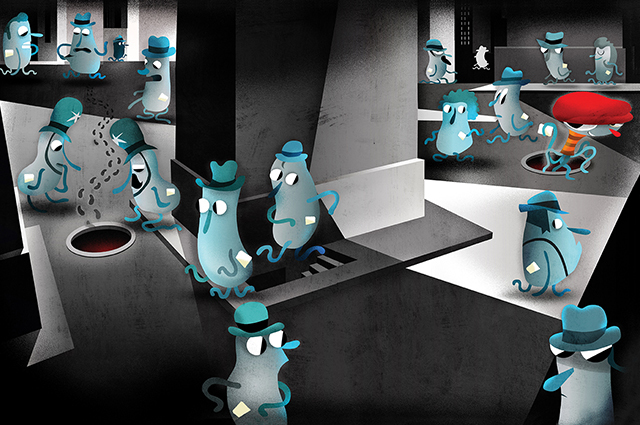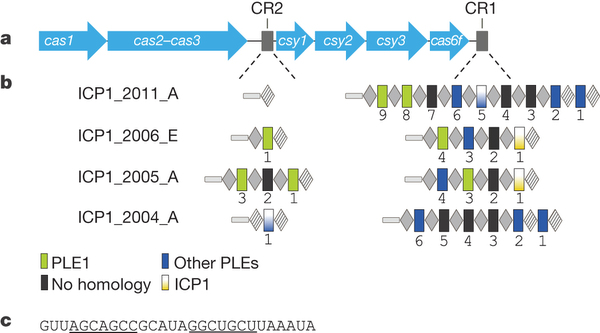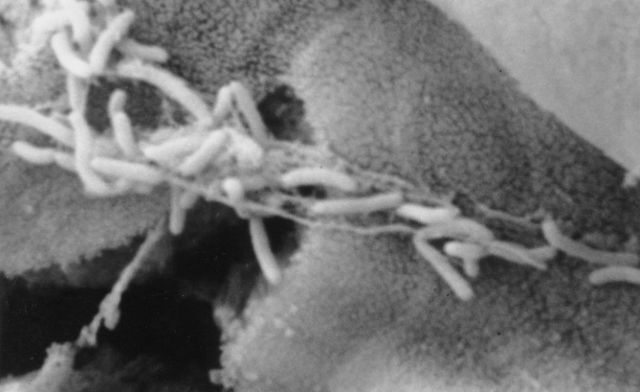Bacteriophage capable of infecting the immune system of bacteria using stolen CRISPR chains
The human immune system is incredibly complex and amazingly effective. In real-time, it reflects the mass of external threats, familiar and new, while learning to quickly recognize unfamiliar dangers. A cascade of complex biochemical reactions allows us to constantly improve the acquired immunity, producing specialized antibodies that instantly react to the already familiar danger before the infection spreads to the entire body. But, as shown by studies conducted by Professor Andrew Kamilli over the past few years, and more recently, by the famous virologist Curtis Sattle, viruses have learned to deal with us with our own weapons. We will tell about what mechanisms they use for this purpose in today's publication.

The role of ordinary soldiers on the front line in the fight against external threats is accounted for by bacteria, sometimes attacked by viruses, bacteriophages. To defeat the enemy, bacteria in the process of evolution also developed their own immune mechanisms - armor, able to protect them from deadly infections. One such mechanism is CRISPR (Clustered Regularly Interspaced Short Palindromic Repeats), a system that allows bacteria to store in their "database" fragments of the genome of bacteriophages, with which it had to meet in the past in order to quickly detect and stop an invasion in the future. . Since 2012, the CRISPR system has also been recommended by scientists as a revolutionary technology for editing the genome.
In a world where countless tiny microbes can infect and kill, such protection becomes our most effective means of resistance. The CRISPR system is thought to have approximately half of the bacteria known to the scientific community. Its defense mechanisms are studied by a team of specialists from the laboratory of Professor of Molecular Biology and Microbiology, Andrew Camilli.
')
“I am constantly amazed at how bacteria can withstand such an onslaught,” says Andrew Kamilli. "... Phages are very cunning." The professor associates the survival ability of some bacteria with the CRISPR / Cas type of immune system. But, as it turned out in the course of the research, this type of system of adaptable immune response is not only the cells of bacteria. In the course of research, scientists came to the conclusion that bacteriophages managed to find an antidote at this level of protection and create an "anti-immune" system, which, given the external simplicity of the organization and structure of these microorganisms, hardly anyone could have expected. And, nevertheless, these seemingly simple structures as part of a small set of genes enclosed in a protein shell, are able to mimic with incredible speed, manifesting miracles of variation.
The creation of such an anti-immune system, according to scientists, was the result of an accidental recombination of the bacteriophage genes and the bacterium at some stage of evolution. Similar in the microworld is not at all uncommon: myriads of bacteria are continually infected with myriads of viruses, and sometimes random fragments of bacterial DNA are embedded in the phage genome, and remain in it as an additional burden. So in theory, the ICP1 phage, which, as Kamilli and his colleagues discovered, managed to “borrow” the entire set of working genes of the CRISPR bacterium, could happen.
The virus was detected by scientists in the analysis of samples obtained in areas of cholera epidemics over a period of 10 years. The authors screened bacteriophages capable of infecting cholera vibrios, and found that in different cases, the set of these viruses can be completely different. And only a single ICP1 was found in all samples. Trying to find an explanation for this phenomenal persistence
bacteriophage, scientists sequenced its genome and found a complete set of genes in the CRISPR system. Thus, having the DNA of the bacterium itself in its “library”, ICP1 introduces complete chaos into the work of its defense systems, making it impossible to effectively resist infection.

Kamilli admits that "... The detected phage, called ICP1, is able to" steal "the entire CRISPR / Cas worker set of the bacteria’s adaptive immune system genes, and there is not a single example of any other pathogen, be it a parasite, a bacterium or a virus that could replicate like. This is the most amazing discovery we’ve made. "

Viruses are nothing more than protein shells wrapped around DNA, and yet their capabilities continue to amaze us, making them think that they are not as simple as they appear at first glance.
The simplest viruses, according to some researchers, are not even alive. At a basic level, these are just protein shells wrapped around DNA. And, nevertheless, they are able to develop and change, and taking into account the results of research, this may mean that they are much more adapted to combat human immunity than scientists thought.
A working CRISPR / Cas system found in a bacteriophage can help a virus attack and break the protective barrier of the bacteria. If this is true, then Camilli’s research team can make a huge difference to medicine. Once scientists understand exactly how phage use CRISPR / Cas, infecting and killing bacteria, it will be possible to use this knowledge to synthesize phages that can counteract diseases, such as cholera, much more effectively than existing antibiotics.

Resistant bacteria that are resistant to most modern antibiotics are already detected around the world. With the disabilities of modern drugs, treatment is increasingly ineffective. Bacteriophages are able to offer an alternative treatment regimen. Compared to the development of new antibiotics for many years and many millions of dollars, the synthesis of a new phage is incommensurably simpler. “You can isolate phages that will be able to kill a particular type of bacteria in just one week,” said Professor Kamilli. The report on the results of the work of the Kamilli group was published immediately in several authoritative publications, including Nature (23.02.2013).
Recent research in this direction
Research by Professor Kamilli, which became the property of the scientific community in 2013, only recently found another confirmation, but from a different angle in the work of a group of microbiologists from the University of British Columbia , Canada, led by the well-known virologist Curtis Suttle ).
They found that a virus like Cyanophage N1 is capable of transmitting CRISPR among related cyanobacteria and, thus, provides resistance to infections with competing phages. “This behavior of the cyanophage will be appropriate to compare with the actions of a hacker attacking a computer system and immediately correcting the consequences of their actions in order to be sure that other hackers no longer use the snake they found,” commented Sattle.
“Bacteria and viruses have a common evolutionary history going back billions of years,” continues Sattle, “And at some point in this story, the N1 virus borrowed several protective CRISPR sequences from the cyanobacteria of the species Nostoc , Anabaena and their closest tribesmen. And now he uses the stolen items in order to successfully attack and, at the same time, protect them from competing viruses, ensuring the survival of environmentally important cyanobacteria. "
It is worth adding that the bacteria Nostoc and Anabaena, affected by cyanophage N1, belong to the species of cyanobacteria living on the globe almost everywhere. Their ancestors once produced most of the oxygen found in the atmosphere of the Earth, and the bacteria Nostoc and their closest "relatives" remain the source of a very, very significant part of the oxygen that is vital for us today.
You can learn more about the research results of the Sattle group on the pages of the mBio magazine of the American Society of Microbiology on June 14, 2016 .
That's all with you was Dronk.Ru. Do not forget to return money for purchases in China and subscribe to our blog , there will be many more interesting things.

We recommend:
- Save up to 8% on every purchase on AliExpress and other online stores in China
- Why do online stores give money for purchases?
- Return your money - Choose a cashback service for Aliexpress
- The history of the development of Dronk.ru - from choosing quadcopters to returning money for purchases on AliExpress and not only
- The best cashback service or 5 main criteria for evaluating cashback service

The role of ordinary soldiers on the front line in the fight against external threats is accounted for by bacteria, sometimes attacked by viruses, bacteriophages. To defeat the enemy, bacteria in the process of evolution also developed their own immune mechanisms - armor, able to protect them from deadly infections. One such mechanism is CRISPR (Clustered Regularly Interspaced Short Palindromic Repeats), a system that allows bacteria to store in their "database" fragments of the genome of bacteriophages, with which it had to meet in the past in order to quickly detect and stop an invasion in the future. . Since 2012, the CRISPR system has also been recommended by scientists as a revolutionary technology for editing the genome.
In a world where countless tiny microbes can infect and kill, such protection becomes our most effective means of resistance. The CRISPR system is thought to have approximately half of the bacteria known to the scientific community. Its defense mechanisms are studied by a team of specialists from the laboratory of Professor of Molecular Biology and Microbiology, Andrew Camilli.
')
“I am constantly amazed at how bacteria can withstand such an onslaught,” says Andrew Kamilli. "... Phages are very cunning." The professor associates the survival ability of some bacteria with the CRISPR / Cas type of immune system. But, as it turned out in the course of the research, this type of system of adaptable immune response is not only the cells of bacteria. In the course of research, scientists came to the conclusion that bacteriophages managed to find an antidote at this level of protection and create an "anti-immune" system, which, given the external simplicity of the organization and structure of these microorganisms, hardly anyone could have expected. And, nevertheless, these seemingly simple structures as part of a small set of genes enclosed in a protein shell, are able to mimic with incredible speed, manifesting miracles of variation.
The creation of such an anti-immune system, according to scientists, was the result of an accidental recombination of the bacteriophage genes and the bacterium at some stage of evolution. Similar in the microworld is not at all uncommon: myriads of bacteria are continually infected with myriads of viruses, and sometimes random fragments of bacterial DNA are embedded in the phage genome, and remain in it as an additional burden. So in theory, the ICP1 phage, which, as Kamilli and his colleagues discovered, managed to “borrow” the entire set of working genes of the CRISPR bacterium, could happen.
The virus was detected by scientists in the analysis of samples obtained in areas of cholera epidemics over a period of 10 years. The authors screened bacteriophages capable of infecting cholera vibrios, and found that in different cases, the set of these viruses can be completely different. And only a single ICP1 was found in all samples. Trying to find an explanation for this phenomenal persistence
bacteriophage, scientists sequenced its genome and found a complete set of genes in the CRISPR system. Thus, having the DNA of the bacterium itself in its “library”, ICP1 introduces complete chaos into the work of its defense systems, making it impossible to effectively resist infection.

Kamilli admits that "... The detected phage, called ICP1, is able to" steal "the entire CRISPR / Cas worker set of the bacteria’s adaptive immune system genes, and there is not a single example of any other pathogen, be it a parasite, a bacterium or a virus that could replicate like. This is the most amazing discovery we’ve made. "

Viruses are nothing more than protein shells wrapped around DNA, and yet their capabilities continue to amaze us, making them think that they are not as simple as they appear at first glance.
The simplest viruses, according to some researchers, are not even alive. At a basic level, these are just protein shells wrapped around DNA. And, nevertheless, they are able to develop and change, and taking into account the results of research, this may mean that they are much more adapted to combat human immunity than scientists thought.
A working CRISPR / Cas system found in a bacteriophage can help a virus attack and break the protective barrier of the bacteria. If this is true, then Camilli’s research team can make a huge difference to medicine. Once scientists understand exactly how phage use CRISPR / Cas, infecting and killing bacteria, it will be possible to use this knowledge to synthesize phages that can counteract diseases, such as cholera, much more effectively than existing antibiotics.

Resistant bacteria that are resistant to most modern antibiotics are already detected around the world. With the disabilities of modern drugs, treatment is increasingly ineffective. Bacteriophages are able to offer an alternative treatment regimen. Compared to the development of new antibiotics for many years and many millions of dollars, the synthesis of a new phage is incommensurably simpler. “You can isolate phages that will be able to kill a particular type of bacteria in just one week,” said Professor Kamilli. The report on the results of the work of the Kamilli group was published immediately in several authoritative publications, including Nature (23.02.2013).
Recent research in this direction
Research by Professor Kamilli, which became the property of the scientific community in 2013, only recently found another confirmation, but from a different angle in the work of a group of microbiologists from the University of British Columbia , Canada, led by the well-known virologist Curtis Suttle ).
They found that a virus like Cyanophage N1 is capable of transmitting CRISPR among related cyanobacteria and, thus, provides resistance to infections with competing phages. “This behavior of the cyanophage will be appropriate to compare with the actions of a hacker attacking a computer system and immediately correcting the consequences of their actions in order to be sure that other hackers no longer use the snake they found,” commented Sattle.
“Bacteria and viruses have a common evolutionary history going back billions of years,” continues Sattle, “And at some point in this story, the N1 virus borrowed several protective CRISPR sequences from the cyanobacteria of the species Nostoc , Anabaena and their closest tribesmen. And now he uses the stolen items in order to successfully attack and, at the same time, protect them from competing viruses, ensuring the survival of environmentally important cyanobacteria. "
It is worth adding that the bacteria Nostoc and Anabaena, affected by cyanophage N1, belong to the species of cyanobacteria living on the globe almost everywhere. Their ancestors once produced most of the oxygen found in the atmosphere of the Earth, and the bacteria Nostoc and their closest "relatives" remain the source of a very, very significant part of the oxygen that is vital for us today.
You can learn more about the research results of the Sattle group on the pages of the mBio magazine of the American Society of Microbiology on June 14, 2016 .
That's all with you was Dronk.Ru. Do not forget to return money for purchases in China and subscribe to our blog , there will be many more interesting things.

We recommend:
- Save up to 8% on every purchase on AliExpress and other online stores in China
- Why do online stores give money for purchases?
- Return your money - Choose a cashback service for Aliexpress
- The history of the development of Dronk.ru - from choosing quadcopters to returning money for purchases on AliExpress and not only
- The best cashback service or 5 main criteria for evaluating cashback service
Source: https://habr.com/ru/post/369423/
All Articles